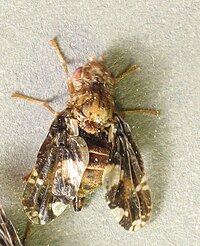
Photo from wikipedia
Understanding the cellular mechanisms mediating invasive plant adaptation to excessive cadmium (Cd) in environments is crucial for designing phytoremediation strategies for Cd-contaminated soils. Here we performed RNA sequencing on the… Click to show full abstract
Understanding the cellular mechanisms mediating invasive plant adaptation to excessive cadmium (Cd) in environments is crucial for designing phytoremediation strategies for Cd-contaminated soils. Here we performed RNA sequencing on the root and leaf tissues of Solidago canadensis stressed by Cd for 0, 12, 24, and 48 h. Tissue-specific gene expression was notably significant, i.e., 76% (1667) of differentially expressed unigenes in the root and 78% (1856) in the leaf were exclusive to each tissue. Distinctive enrichment of gene functions was further observed in each tissue's response. In detail, adaptation of the root to Cd stress involved the up-regulation of genes encoding molecular chaperones (mainly heat shock proteins) and induction of some antioxidants, which may help cells scavenge reactive oxygen species (ROS). In comparison, leaf exposure to Cd ramped up the expression of genes associated with secondary metabolism, comprised mainly of cytochrome P450, but slowed down its photosynthetic functions, which seems to conserve energy for survival. Moreover, we highlighted candidate gene modules that are highly linked to physiological traits. Collectively, these observations suggest that S. canadensis may adopt a multipronged approach to actively cope with Cd stress, with both management of ROS accumulation and metabolic adjustment to optimize energy metabolism.
Journal Title: Chemosphere
Year Published: 2022
Link to full text (if available)
Share on Social Media: Sign Up to like & get
recommendations!